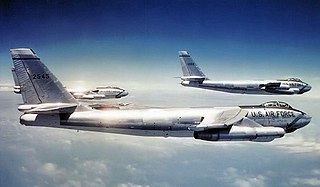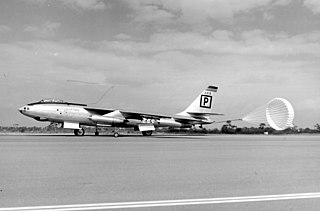
The 303rd Aeronautical Systems Wing was a United States Air Force unit assigned to the Air Force Materiel Command Aeronautical Systems Center, 2005-2010. It was stationed at Wright-Patterson Air Force Base, Ohio as a tenant unit.

The 512th Rescue Squadron is part of the 58th Special Operations Wing based at Kirtland Air Force Base, New Mexico. It formerly operated the Bell UH-1N Twin Huey and currently operates the Sikorsky HH-60G Pave Hawk and the new HH-60W Jolly Green II helicopters training aircrew conducting search and rescue missions.

The 32nd Air Refueling Squadron is part of the 305th Air Mobility Wing at Joint Base McGuire-Dix-Lakehurst, New Jersey. It operates the Boeing KC-46A Pegasus aircraft conducting air refueling missions. The squadron is one of the oldest in the United States Air Force, its origins dating to 19 May 1917, being organized at Camp Kelly, Texas. The squadron deployed to England as part of the American Expeditionary Force during World War I. During World War II, the squadron saw combat service as a Boeing B-17 Flying Fortress unit, assigned to the Fifteenth Air Force in Italy. During the early years of the Cold War, it was a Boeing RB-47 Stratojet strategic reconnaissance squadron as part of Strategic Air Command.

The 349th Air Refueling Squadron is a unit of the US Air Force, part of the 22d Air Refueling Wing at McConnell Air Force Base, Kansas. It operates the Boeing KC-135 Stratotanker aircraft conducting aerial refueling missions.

The 427th Reconnaissance Squadron is an active United States Air Force (USAF) unit assigned to Beale Air Force Base, California.

The 303rd Air Expeditionary Group is a provisional United States Air Force unit. In 2011, it was assigned to United States Air Forces Europe to activate or inactivate as needed.

The 339th Bombardment Squadron is an inactive United States Air Force unit. It was last assigned to the 96th Bombardment Wing at Dyess Air Force Base, Texas, where it was inactivated on 15 March 1963.

The 371st Bombardment Squadron is an inactive United States Air Force unit. Its last assignment was with the 307th Bombardment Wing at Lincoln Air Force Base, Nebraska, where it was inactivated on 25 March 1965.

The 372nd Bombardment Squadron is an inactive United States Air Force unit. Its last assignment was with the 307th Bombardment Wing at Lincoln Air Force Base, Nebraska, where it was inactivated on 25 March 1965.

The 368th Training Squadron is a United States Air Force ground training unit, located at Fort Leonard Wood, Missouri. The squadron reports to the 782d Training Group, part of the 82d Training Wing, at Sheppard Air Force Base, Texas and conducts training for airmen in civil engineering, as well as in Logistics Readiness in Ground Transportation.

The 369th Bombardment Squadron is an inactive United States Air Force unit. Its last assignment was with the 306th Bombardment Wing stationed at MacDill Air Force Base, Florida.

The 322d Expeditionary Reconnaissance Squadron is a provisional unit of the United States Air Force, assigned to Air Combat Command to activate or inactivate as needed.

The 353d Bombardment Squadron is an inactive United States Air Force unit. It last was assigned to the 301st Bombardment Wing, stationed at Lockbourne Air Force Base, Ohio. It was inactivated on 8 June 1964.

The 352d Bombardment Squadron is an inactive United States Air Force unit. It was last assigned to the 301st Bombardment Wing at Lockbourne Air Force Base, Ohio, where it was inactivated on 8 June 1964.

The 358th Bombardment Squadron is an inactive United States Air Force unit. It was last assigned to the 303d Bombardment Wing at Davis–Monthan Air Force Base, Arizona, where it was inactivated on 15 June 1964.

The 359th Bombardment Squadron was a United States Air Force unit. It was last assigned to the 303d Bombardment Wing, stationed at Davis–Monthan Air Force Base, Arizona. It was inactivated on 15 June 1964.

The 342d Bombardment Squadron is an inactive United States Air Force unit. It was last assigned to the 4137th Strategic Wing at Robins Air Force Base, Georgia, where it was inactivated on 1 February 1963.

The 366th Bombardment Squadron is an inactive United States Air Force unit. It was first activated in March 1942. After training with Boeing B-17 Flying Fortress bombers in the United States, the squadron deployed to the European Theater of Operations, where it participated in the strategic bombing campaign against Germany. The squadron was twice awarded the Distinguished Unit Citation for its combat actions. Following V-E Day, it moved to the continent of Europe and engaged in photographic mapping until inactivating in December 1946.

The 365th Bombardment Squadron is an inactive United States Air Force unit. It was first activated in March 1942. After training with Boeing B-17 Flying Fortress bombers in the United States, the squadron deployed to the European Theater of Operations, where it participated in the strategic bombing campaign against Germany. The squadron was twice awarded the Distinguished Unit Citation for its combat actions. Following V-E Day, it moved to the continent of Europe and engaged in photographic mapping until inactivating in December 1946.

The 364th Bombardment Squadron is an inactive United States Air Force unit. Its last assignment was with the 305th Bombardment Wing at Bunker Hill Air Force Base, Indiana, where it was inactivated on 1 January 1970. The squadron was first activated in March 1942. After training in the United States, it moved to England in the fall of 1942, where it participated in the strategic bombing campaign against Germany, earning a Distinguished Unit Citation for its actions. Following V-E Day, the squadron moved to Germany, where it formed part of the occupation forces until inactivating in December 1946.




















